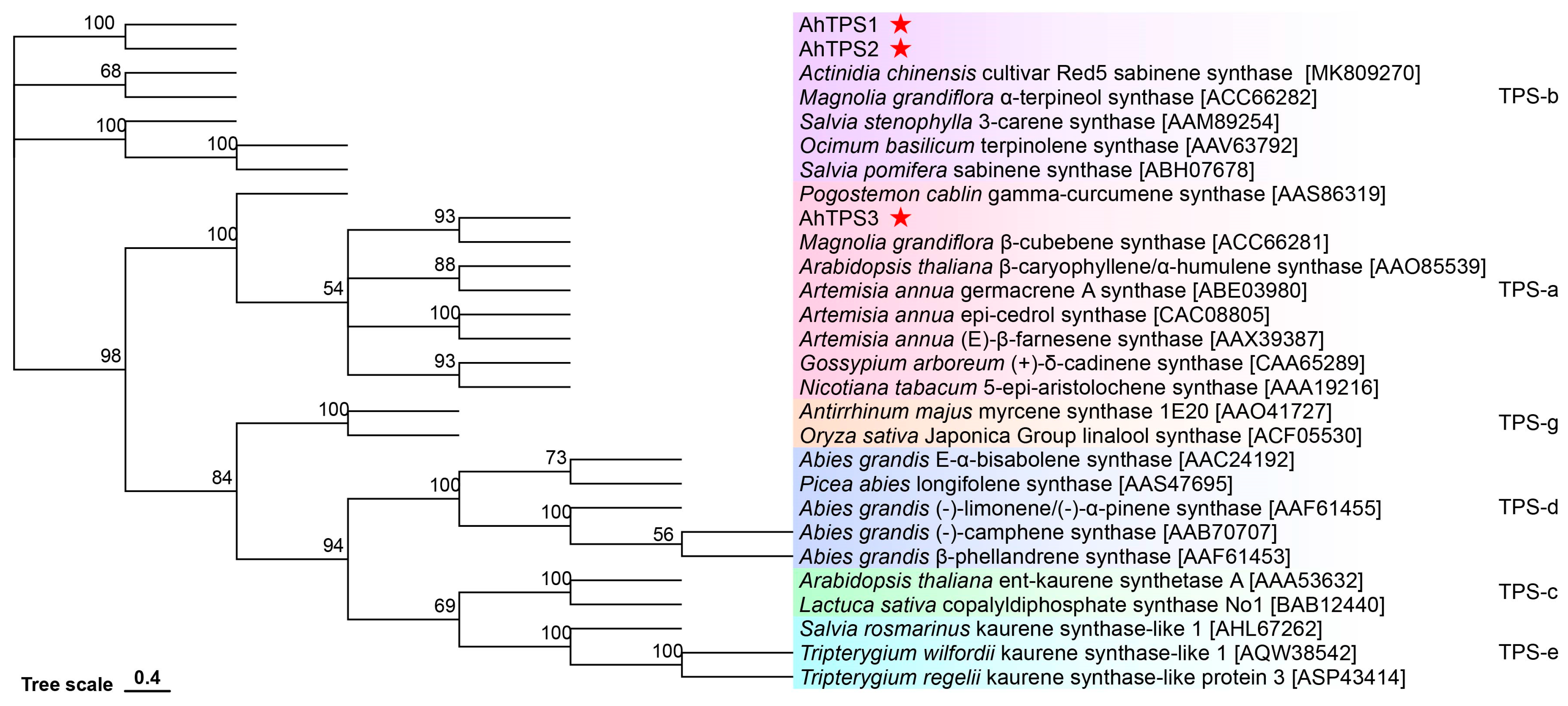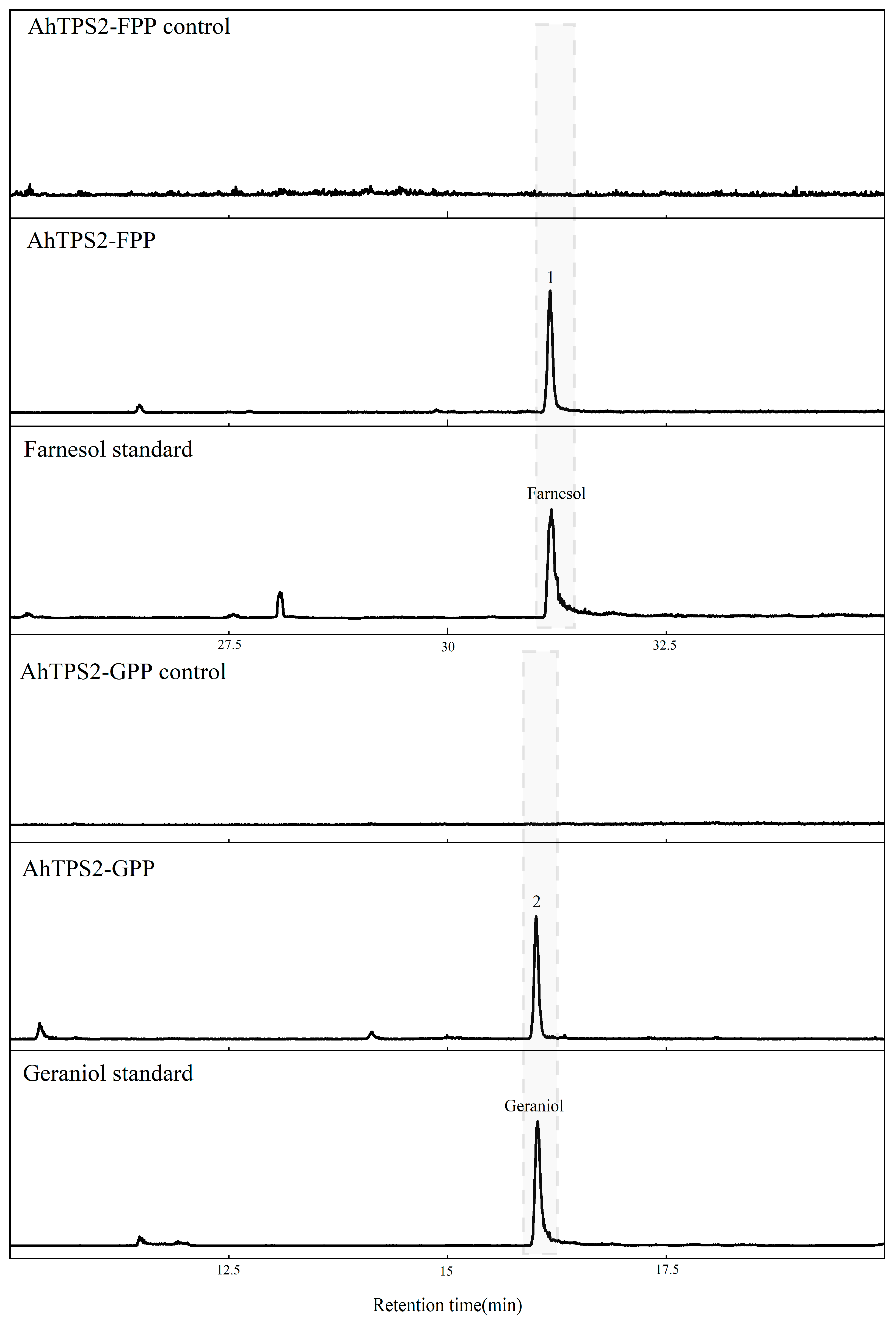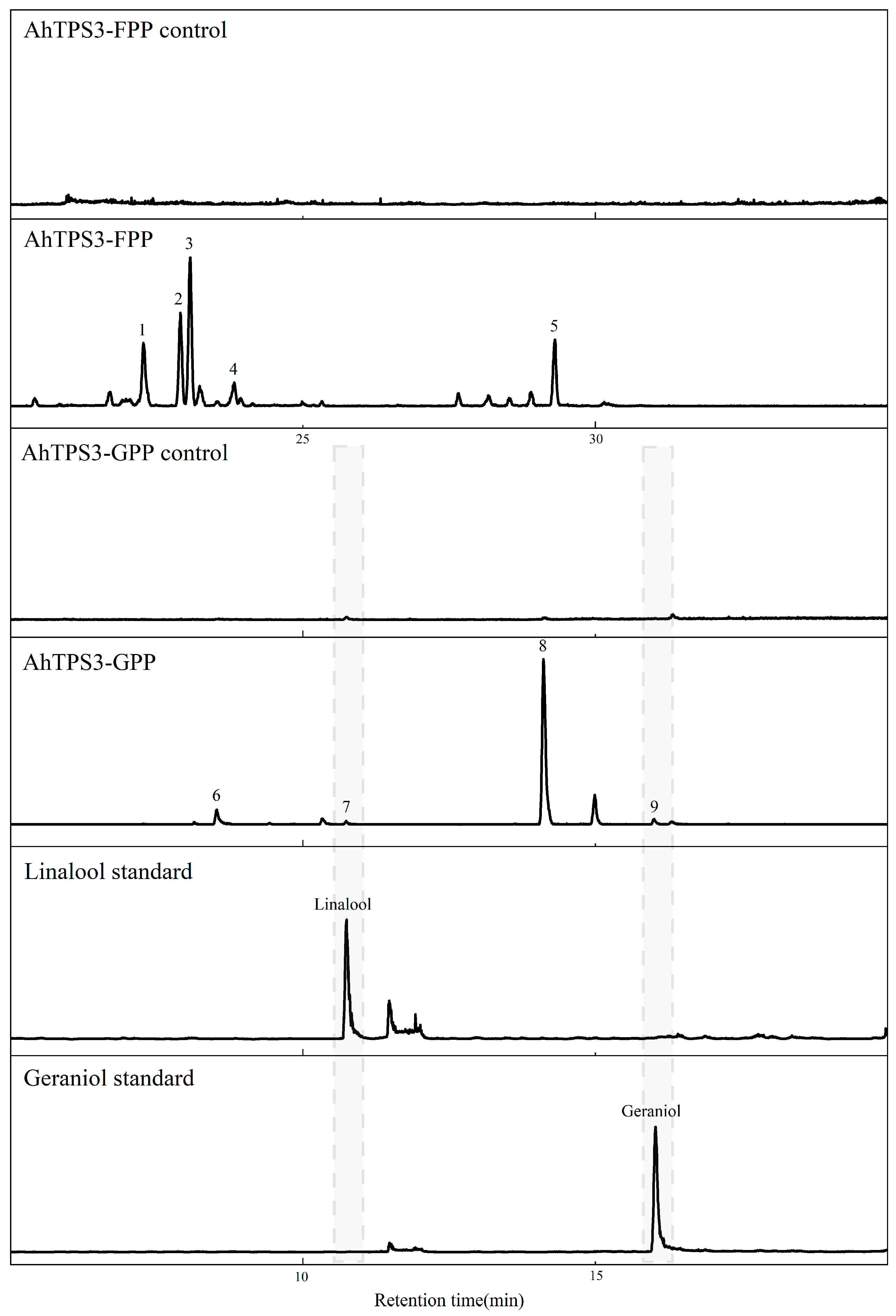Isolation and Characterization of Two Monoterpene Synthases and a Sesquiterpene Synthase from Asarum heterotropoides
Abstract
1. Introduction
2. Materials and Methods
2.1. Plant Materials and Chemicals
2.2. Essential Oil Extraction
2.3. Sequence Alignment and Phylogenetic Analysis
2.4. Molecular Docking of GPP and FPP
2.5. RNA Extraction and cDNA Synthesis
2.6. Prokaryotic Expression and Protein Purification
2.7. Enzyme Assay
2.8. Gas Chromatography–Mass Spectrometry Analysis
2.9. Subcellular Localization Analysis
3. Results
3.1. Essential Oil of A. heterotropoides Root Determined by GC-MS
3.2. Cloning of Monoterpene and Sesquiterpene Synthases
3.3. Molecular Docking
3.4. Enzymatic Activities of AhTPS1, AhTPS2, and AhTPS3
3.5. Subcellular Localization of AhTPS1, AhTPS2, and AhTPS3
4. Discussion
Supplementary Materials
Author Contributions
Funding
Institutional Review Board Statement
Informed Consent Statement
Data Availability Statement
Acknowledgments
Conflicts of Interest
References
- Wu, W.-K.; Nie, G.-B.; Lin, J.-L.; Huang, J.-F.; Guo, X.-X.; Chen, M.; Fang, X.; Mao, Y.; Li, Y.; Wang, L.; et al. Regulation of glandular size and phytoalexin biosynthesis by a negative feedback loop in cotton. Adv. Sci. 2024, 11, 2403059. [Google Scholar] [CrossRef] [PubMed]
- Dudareva, N.; Klempien, A.; Muhlemann, J.K.; Kaplan, I. Biosynthesis, function and metabolic engineering of plant volatile organic compounds. New Phytol. 2013, 198, 16–32. [Google Scholar] [CrossRef]
- Stirling, S.A.; Guercio, A.M.; Patrick, R.M.; Huang, X.-Q.; Bergman, M.E.; Dwivedi, W. Volatile communication in plants relies on a KAI2-mediated signaling pathway. Science 2024, 383, 1318–1325. [Google Scholar] [CrossRef]
- Christianson, D.W. Structural and chemical biology of terpenoid cyclases. Chem. Rev. 2017, 117, 11570–11648. [Google Scholar] [CrossRef] [PubMed]
- Bohlmann, J.; Crock, J.; Jetter, R.; Croteau, R. Terpenoid-based defenses in conifers: cDNA cloning, characterization, and functional expression of wound-inducible (E)-α-bisabolene synthase from grand fir (Abies grandis). Proc. Natl. Acad. Sci. USA 1998, 95, 6756–6761. [Google Scholar] [CrossRef]
- Chen, F.; Tholl, D.; Bohlmann, J.; Pichersky, E. The family of terpene synthases in plants: A mid-size family of genes for specialized metabolism that is highly diversified throughout the kingdom. Plant J. 2011, 66, 212–229. [Google Scholar] [CrossRef]
- Dudareva, N.; Martin, D.; Kish, C.M.; Kolosova, N.; Gorenstein, N.; Faldt, J.; Miller, B.; Bohlmann, J. (E)-β-ocimene and myrcene synthase genes of floral scent biosynthesis in snapdragon: Function and expression of three terpene synthase genes of a new terpene synthase subfamily. Plant Cell 2003, 15, 1227–1241. [Google Scholar] [CrossRef]
- Huang, J.Q.; Fang, X. Amorpha-4,11-diene synthase: A key enzyme in artemisinin biosynthesis and engineering. aBIOTECH 2021, 2, 276–288. [Google Scholar] [CrossRef]
- Kelly, L.M. Phylogenetic relationships in Asarum (Aristolochiaceae) based on morphology and ITS sequences. Am. J. Bot. 1998, 85, 1454–1467. [Google Scholar] [CrossRef] [PubMed]
- Tian, J.; Liu, C.; Wang, L.; Xian, Z.; Zhao, Y.; Qin, S.S.; Yi, Y.; Li, C.Y.; Han, J.Y.; Pan, C.; et al. Study on the difference and correlation between the contents and toxicity of aristolochic acid analogues in Aristolochia plants. J. Ethnopharmacol. 2023, 315, 116568. [Google Scholar] [CrossRef]
- Chinese Pharmacopoeia Commission. Pharmacopoeia of the People’s Republic of China (Volume I); Chinese Medicine Science and Technology Press: Beijing, China, 2020; pp. 240–242.
- Haque, A.S.M.T.; Moon, J.N.; Saravana, P.S.; Tilahun, A.; Chun, B.S. Composition of Asarum heterotropoides var. mandshuricum radix oil from different extraction methods and activities against human body odor-producing bacteria. J. Food Drug Anal. 2016, 24, 813–821. [Google Scholar] [CrossRef]
- Wang, X.; Hui, F.; Yang, Y.; Yang, S. Deep sequencing and transcriptome analysis to identify genes related to biosynthesis of aristolochic acid in Asarum heterotropoides. Sci. Rep. 2018, 8, 17850. [Google Scholar] [CrossRef]
- Sun, Y.-T.; Xue, L.; Zhang, G.-H.; Wang, Y.-D.; Ma, H.-X.; Jin, C.-Y.; Du, X.-B.; Zhang, Y.-H.; Zhang, L. Study on the insecticidal activity and mechanism of essential oil of Asarum heterotropoides against Bactrocera dorsalis. J. Anhui Agric. Sci. 2024, 52, 128–132. [Google Scholar]
- Xiao, Y.; Zhao, R.; Liu, Z.; Zhang, L.; Gu, H.Y.; Yang, F.J.; Yang, L.; Liu, T.T. An efficient method to obtain essential oil from Asarum heterotropoides via homogenate-microwave-assisted hydrodistillation and evaluation of Fusarium species inhibition activity in vitro compared to its main components. Ind. Crops Prod. 2023, 194, 116366. [Google Scholar] [CrossRef]
- Zhang, Z.; Kang, H. Protective effect of Asarum sieboldii essential oil on ovalbumin induced allergic rhinitis in rat. Biosci. Rep. 2020, 40, BSR20191370. [Google Scholar] [CrossRef] [PubMed]
- Chen, F.; Zhang, Q.; Gu, H.Y.; Yang, L. A modified approach for separating essential oil from the roots and rhizomes of Asarum heterotropoides var. mandshuricum. J. Clean. Prod. 2018, 172, 2075–2089. [Google Scholar] [CrossRef]
- Fang, X.; Li, C.-Y.; Yang, Y.; Cui, M.-Y.; Chen, X.-Y.; Yang, L. Identification of a novel (-)-5-epieremophilene synthase from Salvia miltiorrhiza via transcriptome mining. Front. Plant Sci. 2017, 8, 627. [Google Scholar] [CrossRef] [PubMed]
- Wang, B.; Qi, W.; Wang, L.; Kong, D.; Kano, Y.; Li, J.; Yuan, D. Comparative study of chemical composition, antinociceptive effect and acute toxicity of the essential oil of three Asarum drugs. J. Chin. Pharm. Sci. 2014, 23, 480–489. [Google Scholar] [CrossRef]
- Li, J.J.; Yan, W.; Cui, E.J.; Zhen, J.C. GC-MS analysis of volatile oil components of Asarum from different habitats. Lishizhen Med. Mate. Med. Res. 2019, 30, 188–190. [Google Scholar] [CrossRef]
- Qian, S.S.; Liu, M.R.; Rong, R.; Yang, Y. Research progress in chemical constituents, pharmacology and toxicology of volatile oil in Asarum. Chin. J. Pharmacov. 2021, 18, 388–395. [Google Scholar]
- Williams, D.C.; McGarvey, D.J.; Katahira, E.J.; Croteau, R. Truncation of limonene synthase preprotein provides a fully active ‘Pseudomature’ form of this monoterpene cyclase and reveals the function of the amino-terminal arginine pair. Biochemistry 1998, 37, 12213–12220. [Google Scholar] [CrossRef]
- Ruan, J.X.; Li, J.X.; Fang, X.; Wang, L.J.; Hu, W.L.; Chen, X.Y.; Yang, C.Q. Isolation and characterization of three new monoterpene synthases from Artemisia annua. Front. Plant Sci. 2016, 7, 638. [Google Scholar] [CrossRef] [PubMed]
- Biasini, M.; Bienert, S.; Waterhouse, A.; Arnold, K.; Studer, G.; Schmidt, T.; Kiefer, F.; Gallo, C.; Tiziano, B.M.; Bordoli, L.; et al. SWISS-MODEL: Modelling protein tertiary and quaternary structure using evolutionary information. Nucleic Acids Res. 2014, 42, 252–258. [Google Scholar] [CrossRef]
- Ashaar, N.S.; Rahim, M.H.A.; Sabri, S.; Lai, K.S.; Song, A.A.L.; Rahim, R.A.; Abdullah, J.O. Kinetic studies and homology modeling of a dual-substrate linalool/nerolidol synthase from Plectranthus amboinicus. Sci. Rep. 2021, 11, 17094. [Google Scholar] [CrossRef] [PubMed]
- Kosuge, T.; Yokota, M.; Nukaya, H.; Gotoh, Y.; Nagasawa, M. Studies on antitussive principles of Asiasari Radix. Chem. Pharm. Bull. 1978, 26, 2284–2285. [Google Scholar] [CrossRef]
- Huang, J.; Wang, H.Q.; Zhang, C.; Li, G.Y.; Lin, R.C.; Wang, J.H. A new tetrahydrofuran-type lignan with anti-inflammatory activity from Asarum heterotropoides Fr. Schmidt var. mandshuricum. J. Asian Nat. Prod. Res. 2014, 16, 387–392. [Google Scholar] [CrossRef] [PubMed]
- Jing, Y.; Zhang, Y.F.; Shang, M.Y.; Liu, G.X.; Li, Y.L.; Wang, X.; Cai, S.Q. Chemical constituents from the roots and rhizomes of Asarum heterotropoides var. mandshuricum and the in vitro anti-inflammatory activity. Molecules 2017, 22, 125. [Google Scholar] [CrossRef]
- Liu, J.J.; Xu, C.; Zhang, H.L.; Liu, F.W.; Ma, D.M.; Liu, Z. Comparative Transcriptomics Analysis for Gene Mining and Identification of a Cinnamyl Alcohol Dehydrogenase Involved in Methyleugenol Biosynthesis from Asarum sieboldii Miq. Molecules 2019, 23, 3184. [Google Scholar] [CrossRef]
- Liu, F.W.; Ali, T.; Liu, Z. Molecular cloning and characterization of Cinnamoyl-CoA reductase promoter gene from Asarum sieboldii Miq. Biotechnol. Appl. Biochem. 2022, 70, 83–96. [Google Scholar] [CrossRef]
- Degenhardt, J.; Kollner, T.G.; Gershenzon, J. Monoterpene and sesquiterpene synthases and the origin of terpene skeletal diversity in plants. Phytochemistry 2009, 70, 1621–1637. [Google Scholar] [CrossRef]
- Hink, W.F.; Liberati, T.A.; Collart, M.G. Toxicity of linalool to life stages of the cat flea, Ctenocephalides felis (Siphonaptera: Pulicidae), and its efficacy in carpet and on animals. J. Med. Entomol. 1998, 25, 1–4. [Google Scholar] [CrossRef]
- Davidovich-Rikanati, R.; Lewinsohn, E.; Bar, E.; Lijima, Y.; Pichersky, E.; Sitrit, Y. Overexpression of the lemon basil α-zingiberene synthase gene increases both mono- and sesquiterpene contents in tomato fruit. Plant J. 2008, 56, 228–238. [Google Scholar] [CrossRef]
- Dong, L.; Jongedijk, E.; Bouwmeester, H.; Van Der Krol, A. Monoterpene biosynthesis potential of plant subcellular compartments. New Phytol. 2016, 209, 679–690. [Google Scholar] [CrossRef]
- Conart, C.; Bomzen, D.P.; Huang, X.Q.; Bassard, J.E.; Paramita, S.N.; Saint-Marcoux, D.; Rius-Bony, A.; Hiver, G.; Anchisi, A.; Schaller, H.; et al. A cytosolic bifunctional geranyl/farnesyl diphosphate synthase provides MVA-derived GPP for geraniol biosynthesis in rose flowers. Proc. Natl. Acad. Sci. USA 2023, 120, e2221440120. [Google Scholar] [CrossRef]
- Yang, C.Q.; Fang, X.; Wu, X.M.; Mao, Y.B.; Wang, L.J.; Chen, X.Y. Transcriptional regulation of plant secondary metabolism. J. Integr. Plant Biol. 2012, 54, 703–712. [Google Scholar] [CrossRef]
- Mao, Y.B.; Liu, Y.Q.; Chen, D.Y.; Chen, F.Y.; Fang, X.; Hong, G.J.; Wang, L.J.; Wang, J.W.; Chen, X.Y. Jasmonate response decay and defense metabolite accumulation contributes to age-regulated dynamics of plant insect resistance. Nat. Commun. 2015, 8, 13925. [Google Scholar] [CrossRef] [PubMed]
- Huang, J.Q.; Li, D.M.; Tian, X.; Lin, J.L.; Yang, L.; Xu, J.J.; Fang, X. Side products of recombinant amorpha-4,11-diene synthase and their effect on microbial artemisinin production. J. Agric. Food Chem. 2021, 69, 2168–2178. [Google Scholar] [CrossRef] [PubMed]
- Mercke, P.; Kappers, I.F.; Verstappen, F.W.A.; Vorst, O.; Dicke, M.; Bouwmeester, H.J. Combined transcript and metabolite analysis reveals genes involved in spider mite induced volatile formation in Cucumber plants. Plant Physiol. 2024, 135, 2012–2024. [Google Scholar] [CrossRef] [PubMed]
- Pazouki, L.; Niinemets, Ü. Multi-Substrate Terpene Synthases: Their Occurrence and Physiological Significance. Front. Plant Sci. 2016, 7, 1019. [Google Scholar] [CrossRef]








Disclaimer/Publisher’s Note: The statements, opinions and data contained in all publications are solely those of the individual author(s) and contributor(s) and not of MDPI and/or the editor(s). MDPI and/or the editor(s) disclaim responsibility for any injury to people or property resulting from any ideas, methods, instructions or products referred to in the content. |
© 2025 by the authors. Licensee MDPI, Basel, Switzerland. This article is an open access article distributed under the terms and conditions of the Creative Commons Attribution (CC BY) license (https://creativecommons.org/licenses/by/4.0/).
Share and Cite
Li, J.; Shen, Q.; Zhang, Y.; Tao, H.; Xu, B.; Min, X.; Liu, H.; Han, N.; Fang, X. Isolation and Characterization of Two Monoterpene Synthases and a Sesquiterpene Synthase from Asarum heterotropoides. Metabolites 2025, 15, 753. https://doi.org/10.3390/metabo15110753
Li J, Shen Q, Zhang Y, Tao H, Xu B, Min X, Liu H, Han N, Fang X. Isolation and Characterization of Two Monoterpene Synthases and a Sesquiterpene Synthase from Asarum heterotropoides. Metabolites. 2025; 15(11):753. https://doi.org/10.3390/metabo15110753
Chicago/Turabian StyleLi, Jiayi, Qianhua Shen, Yongze Zhang, Hanshu Tao, Bingyi Xu, Xiaoyan Min, Haiyang Liu, Na Han, and Xin Fang. 2025. "Isolation and Characterization of Two Monoterpene Synthases and a Sesquiterpene Synthase from Asarum heterotropoides" Metabolites 15, no. 11: 753. https://doi.org/10.3390/metabo15110753
APA StyleLi, J., Shen, Q., Zhang, Y., Tao, H., Xu, B., Min, X., Liu, H., Han, N., & Fang, X. (2025). Isolation and Characterization of Two Monoterpene Synthases and a Sesquiterpene Synthase from Asarum heterotropoides. Metabolites, 15(11), 753. https://doi.org/10.3390/metabo15110753





